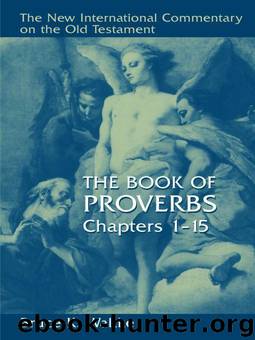Proverbs 1-15 (NICOT) by Bruce K. Waltke

Author:Bruce K. Waltke [Waltke, Bruce K.]
Language: eng
Format: epub
Tags: Religion, Biblical Commentary, Old Testament
ISBN: 9780802825452
Google: kboLy_NBxc4C
Amazon: 0802825451
Publisher: Wm. B. Eerdmans Publishing
Published: 2004-10-13T08:00:00+00:00
c. Conclusion: Wisdom’s Final Invitation and Warning (8:32-36)
The logical particle “so now” (v. 32) and the form of the father’s introductions to his lectures, consisting of addressees (“the sons”), imperatives to “listen” (vv. 32-34), and argumentation or motivation introduced by kî (“because”) (vv. 35-36), mark off the conclusion to the address. In it Woman Wisdom changes her persona, setting, and addressees. She replaces her guise as mediatrix at the city gate addressing the masses (8:1-21) and as a primordial figure beside the Creator (8:22-31) to that of the owner of a house addressing the sons and inviting them to maintain their vigil at her door in order to find her. It is a matter of life and death. In the first strophe she mingles her commands “Listen to me” (vv. 32a, 33) with motivating beatitudes (“blessed is,” vv. 32b, 34a). “Keep” (šāmar) forms an inclusio around the strophe. In the second strophe, linked to the first by initial “because” (kî), she heightens the substantiating motivation to life (v. 35) and death (v. 36). Her command, “Listen to me,” is defined more precisely as “Listen to instruction and do not flout it” (v. 33) and intensified figuratively as intense expectation (v. 34b). Her initial words “So now, sons, listen to me” and her final word, “death,” precisely match the father’s conclusion in the preceding speech (cf. 7:24a, 27b). In the former the father asks the son to marry Wisdom (7:4); now Wisdom asks him to find her as she emerges from the door of her house (8:34). This precise intertextuality between the two great, paired poems of chs. 7 and 8 further validates that Woman Wisdom personifies the sage and his teaching.
32 Since v. 32a parallels v. 33 and v. 32b parallels v. 34, v. 32 probably functions as an introductory summary to vv. 32-34. So now (we'attâ; see 7:24), “often introducing a new subject or section,”1530 signals that the conclusion is a logical deduction from her encomium of self-praise to the masses. Her address to the masses functioned in part as a foil to her other addressees, the sons (see 1:4-5, 8; cf. 1:20-27 and 28-33). Wisdom frames her encomium with listen (šim'û; see 1:8) in the introduction and conclusion to her speech (8:6, 32), showing that this is the point of her encomium. The repetition of “Listen to me” (lî; see 5:7; 7:24) in the conclusions of the diptychs of chs. 7 and 8 strongly suggests that to listen to Woman Wisdom and the sage come to the same thing. She motivates their obedience by the laudatory exclamation, and blessed are those (we’ašrê; see 3:13) who keep (yišmōrû; see 2:8; 8:20) my ways (derākay; see 1:15).
33 The repeated Listen (šim'û) links v. 33 with v. 32a and emphasizes the command. Instruction (mûsār; see 1:2) interprets the metaphor “my ways” in v. 32. Since she has given no chastening word, it probably refers to the following collections of proverbs and sayings (10:1-31:31). And become wise (waḥakāmû; see 6:6) infers that authoritative teaching is the means of developing ethical skill (see pp.
Download
This site does not store any files on its server. We only index and link to content provided by other sites. Please contact the content providers to delete copyright contents if any and email us, we'll remove relevant links or contents immediately.
| New Testament | Old Testament |
The Five People You Meet in Heaven by Mitch Albom(2844)
Name Book, The: Over 10,000 Names--Their Meanings, Origins, and Spiritual Significance by Astoria Dorothy(2492)
Real Sex by Lauren F. Winner(2476)
The Holy Spirit by Billy Graham(2418)
The Secret Power of Speaking God's Word by Joyce Meyer(2253)
0041152001443424520 .pdf by Unknown(2220)
How The Mind Works by Steven Pinker(2214)
Ancient Worlds by Michael Scott(2104)
ESV Study Bible by Crossway(2099)
The Meaning of the Library by unknow(2069)
The Gnostic Gospels by Pagels Elaine(2027)
Churchill by Paul Johnson(2013)
MOSES THE EGYPTIAN by Jan Assmann(1973)
The ESV Study Bible by Crossway Bibles(1918)
Jesus by Paul Johnson(1888)
The Nativity by Geza Vermes(1850)
Ancient Near Eastern Thought and the Old Testament by John H. Walton(1849)
The Complete Dead Sea Scrolls in English (7th Edition) (Penguin Classics) by Geza Vermes(1842)
City of Stairs by Robert Jackson Bennett(1826)
